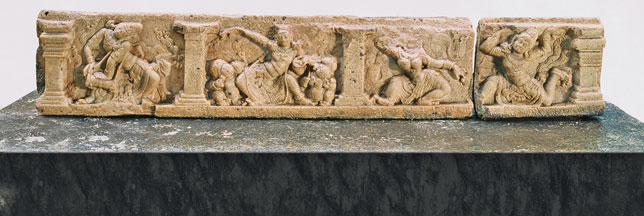Dance depicted in Lanka's ancient stone slabs
by Subashini Pathmanathan
At the Sri Lankan archaeological sites some of the beautiful
slabs have been excavated. On these stone slabs dance figures have
been excellently carved. The dance poses beautifully resemble the
typical Thandava Karana poses of Bharatha Natyam.
According to Hindu mythology, dance was created by Lord Siva. Yet
each Thandava Karana of the Lord is associated with certain dance poses
which have certain philosophical meanings behind them. Many of the
Thandava Karana poses resemble the excellent gymnastic and acrobatic
body positions.
All the carved sculptures might have been done by ancient sculptors
of Sri Lanka. The carved sculptures reveal the typical Indian influence.
Especially the decorations of the carved sculptures reveal the Indian
cultural, traditional and customary impact on the local sculptors.
Archaeological sites
The sculptural dance figures display both male and female dance
poses. They are quite different from the individually crafted
sculptures.

Different types of moonstones can be seen at local archaeological
sites and national museums. The moonstones depict certain philosophical
themes and beautiful decorations.
Some of the beautifully carved sculptural figures could be found on
ruined pillars. Some Hindu temples also have carved decorations on the
rooftop.
Carving on the stone slabs is a very difficult task. Only a
well-experienced sculptor can do such carvings.
While carving the sculptor should take meticulous care to avoid the
cracks on the slabs.
Temple pillars
All the Karana poses of dance are well preserved in stone carvings
and temple pillars of South India. At the Chidambaram temple of Tamil
Nadu all the 108 Thandava Karanas of Lord Siva are depicted.
According to Bharatha Natyam history, a mystic figure named Bharatha
Muni who wrote the Natya sastra.
It consists of 36-chapters dealing with important aspects and
technique of dance and drama. The fourth chapter is allocated for
Thandava Lakshana. According to Bharatha Muni, 'Karana' means a body
position which coordinates with one hand and one leg position called
Chari. Each Thandava Karana of Lord Siva has its own deep meaning. In
dance, 108 Thandava Karanas are fundamental dance poses to depict Lord
Siva.
Bharatha Muni
A combination of Karanas is called Angaharas. According to Bharatha
Muni, there are 32 Angaharas.
In Karana, the body position is in a fixed stance, but in Angaharas,
the body position is continuously changing.
Two Karanas together are called Matrika, three are called kalabhaka,
four are called Mandaka and five are called Sanghataka and six, seven,
eight,or nine Karanas together are called Angaharas.
Another important position in Karanas is Recakas meaning raised or
moving or whirling movements of the body.
They are associated with the neck, hand, waist and body.
In some Karanas the hands are crossed and in others the legs are
crossed.
Lord Siva
The Chidamparam temple has four Gopuras or four temple towers. The
Gopuras face four different directions. Each Gopura was built during
different periods.
The Karanas were arranged one below the other. Each Karana figure is
depicted with musicians, mainly female dancers, singers drummers and
females striking the cymbals.
In temple pillars the Karanas are depicted but they do not seem to
follow any sequence.
The builders appear to have paid special attention to arrange the
Karanas according to Bharaha Muni's Natya Sastra. Under each Karana,
Sanskrit verses of Natya Sastra have been embossed.
Weapons
In the Bragatheeswarar temple of Thanjavur, one could see 81 Thandava
Karanas.
They depict Lord Siva in different postures. The sculptural Karanas
have four arms and two hands with weapons. Even the size of the figure
is bigger than that of the Chidamparam temple.
The Chidamparam Temple is the only place where the 108 Thandava
Karanas with appropriate slokams from Natya Sastra are depicted seen.
Even now, we can see the Karanas in various temples such as
Kumbakonam, Kanchipuram, Maduri, Perur and Virdachalam. |

